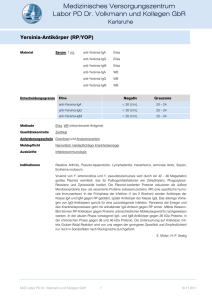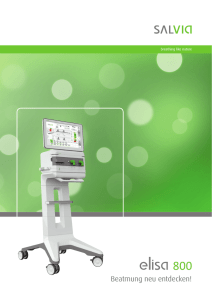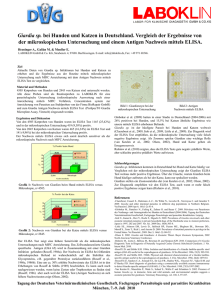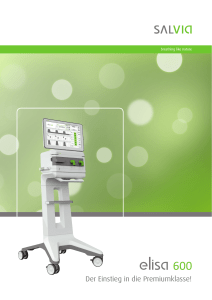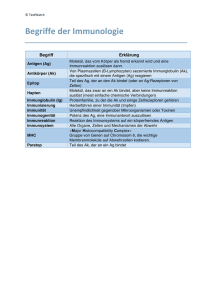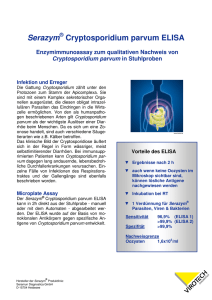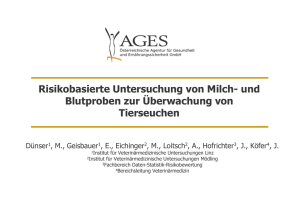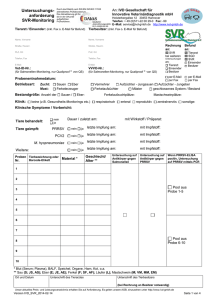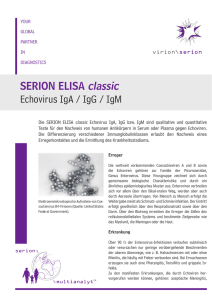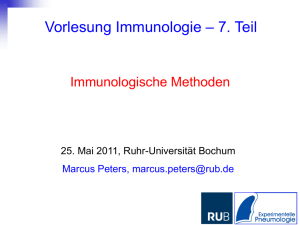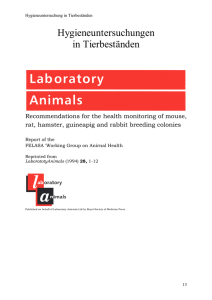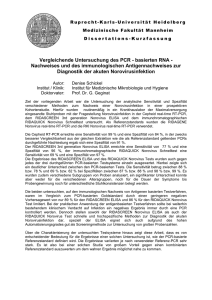Development of an indirect ELISA for the diagnosis of ovine
Werbung
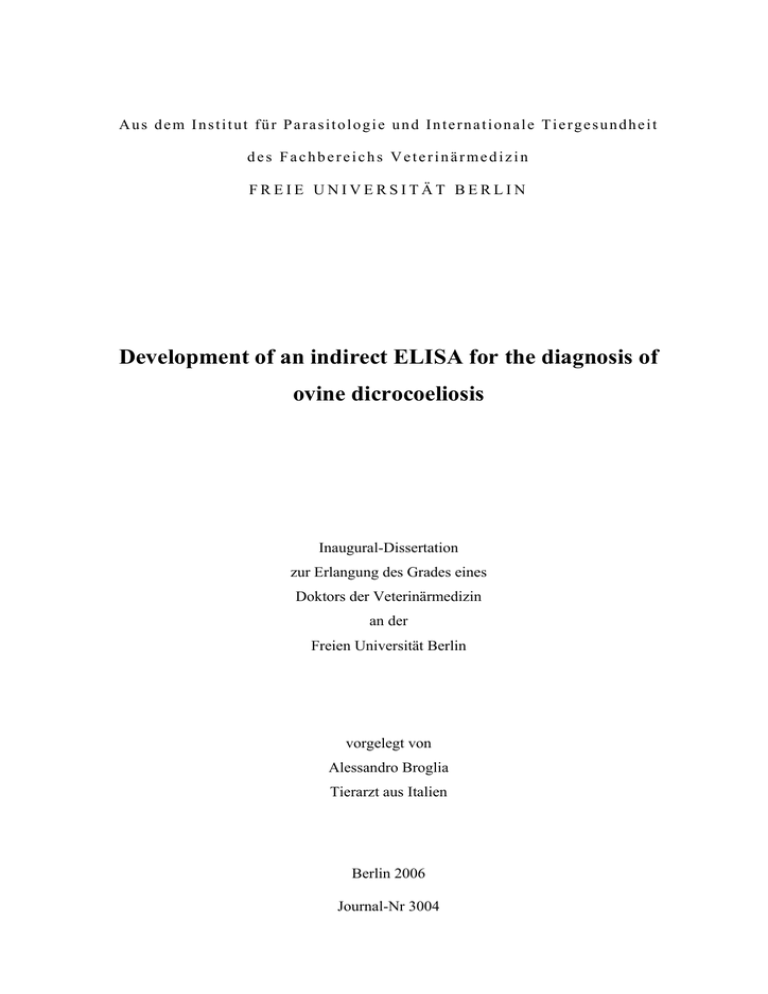
Aus dem Institut für Parasitologie und Internationale Tiergesundheit des Fachbereichs Veterinärmedizin FREIE UNIVERSITÄT BERLIN Development of an indirect ELISA for the diagnosis of ovine dicrocoeliosis Inaugural-Dissertation zur Erlangung des Grades eines Doktors der Veterinärmedizin an der Freien Universität Berlin vorgelegt von Alessandro Broglia Tierarzt aus Italien Berlin 2006 Journal-Nr 3004 Gedruckt mit Genehmigung des Fachbereichs Veterinärmedizin der Freien Universität Berlin Dekan: Univ.-Prof. Dr. L. Brunnberg Erster Gutachter: Prof. Dr. R. Schuster Zweiter Gutachter: Prof. Dr. P. Lanfranchi Dritter Gutachter: Prof. Dr. Dr. h.c. T.Hiepe Deskriptoren (nach CAB-Thesaurus): Dicrocoelium dendriticum; ELISA; sheep disease; parasitosis; diagnostic techniques; immunodiagnosis Tag der Promotion: 22.06.2006 TABLE OF CONTENTS FIGURE LIST…………………………………………................................. TABLE LIST…………………………………………..............................…. i iii 1. INTRODUCTION………………………………………………..................... 1 2. LITERATURE REVIEW………………………………………..................... 3 2.1. Taxonomy of Dicrocoelium spp……………….....................................… 3 2.2. Species……………………………………………...................................... 3 2.3. Morphology……………………………………………………………… 4 2.4. Life cycle…………………………………………………………………. 4 2.5. Epidemiology…………………………………………………………….. 5 2.5.1. Environmental factors……………………………………………… 5 2.5.2. Intermediate hosts………………………………………………….. 6 2.5.3. Definitive host………………………………………………………7 2.6. Pathogenesis, clinical findings and lesions………………………………9 2.7. Diagnosis………………………………………………………………….. 11 2.7.1. Direct methods……………………………………………………... 11 2.7.2. Indirect methods…………………………………………………….12 2.7.2.1. The indirect ELISA (Enzyme-Linked Immunosorbent Assay)………………………………………… 13 2.7.2.2. Enzyme-Assisted Immunoelectroblotting…………………...…14 2.8. Treatment and control of dicrocoeliosis................................................... 17 3. MATERIALS AND METHODS………………………………..................… 20 3.1. Study area.................................................................................................... 20 3.2. Experimental infection............................................................................... 22 3.3. Enzyme -Linked Immunosorbent Assay (ELISA)................................... 23 3.3.1. Antigen preparation………………………………………………... 23 3.3.2. Setting ELISA parameter………………………………………….. 24 3.3.2.1. Titration of antigen……………………………………………… 24 3.3.2.2. Titration of serum……………………………………………….. 24 3.3.2.3. Conjugate and substrate……………………………………….. 24 3.3.2.4. Implementation of ELISA test………………………………….. 25 3.3.2.5. Cut-off definition………………………………………………… 26 3.3.3. Cross-reaction with other parasitic infections………………………26 3.3.3.1. Cross-reaction with Fasciola hepatica and Paramphistomum spp…………………………………………… 26 3.3.3.2. Cross-reaction with nematode parasite infection…………… 27 3.4. Enzyme Immune Transfer Blotting (EITB)……………………………. 28 3.4.1. 3.4.2. 3.4.3. 3.4.4. 3.4.5. Sample treatment…………………………………………………... 28 SDS PAGE…………………………………………………………. 29 Blotting…………………………………………………………….. 30 Immunoassay………………………………………………………. 31 Determination of protein molecular weight………………………... 32 3.5. Field serum samples of sheep flocks from Trentino (Italy)…………. 33 3.5.1. Serum samples……………………………………………………... 35 4. RESULTS………………………………………………………..................…. 37 4.1. Experimental infection.........................................................................….. 37 4.1.1. Ants collection……………………………………………………... 38 4.1.2. Establishment rate………………………………………………….. 39 4.2. ELISA test................................................................................................... 41 4.2.1. 4.2.2. 4.2.3. 4.2.4. Determination of protein concentration of antigen solution……..… 41 Antigen and serum dilution…………………………………………41 Cut off definition……………………………………………………41 Temporal dynamics of IGg response of experimentally infected lambs…………………………………... 43 4.2.5. Cross reaction with other helminths……………………………..… 46 4.2.5.1. Cross -reaction with F. hepatica and Paramphistomum spp…………………………………………… 46 4.2.5.2. Cross-reaction with nematode parasite infection…………....48 4.3. EITB test..................................................................................................... 50 4.3.1. Proteic fractions D. dendriticum antigens of by SDS-PAGE……… 50 4.3.2. Antibody response dynamics in experimentally infected lambs……51 4.3.3. Comparative immunoblot with sera of lambs infected with F. hepatica………………………………………………………………. 53 4.3.4. Comparative immunoblot with sera of lambs infected with others nematodes…………………………………………………………….. 54 4.4. Experimental screening of dicrocoeliosis in sheep flocks in North East Italy (Trentino Province)……………………………………55 4.4.1. Detection of D. chinensis in red deer (Cervus elaphus)in province of Trento………………………………………………………………… 57 5. DISCUSSION………………………………………………….....................… 59 6. CONCLUSIONS……………………………………………........................… 67 7. SUMMARY……………………………………………………….................... 69 8. ZUSAMMENFASSUNG………………………………………..................…. 70 9. REFERENCES…………………………………………………....................... 71 10. APPENDIX............................................................................…......................... 85 10.1. Reagents...................................................................................……. 85 10.1.1. Reagents for antigen preparation…………………………………... 85 10.1.2. Reagent for ELISA test……………………………………………. 85 10.1.3. Reagents for SDS-PAGE………………………………………...… 86 10.1.4. Reagents for Immunoblot………………………………………..… 87 10.2. Tables....................................................................………………… 89 11. ACKNOWLEDGEMENTS.............................................................................. 91 12. CURRICULUM VITAE................................................................................... 92 13. SELBSTANDIGKEITSERKLÄRUNG........................................................... 93 SUMMARY Dicrocoeliosis is a parasitic disease caused by trematodes belonging to the genus Dicrocoelium. These small liver flukes are found in the bile ducts of the definitive host (ruminants, but also equids, lagomorphs, humans), and usually produce no symptoms; only in massive infections can dicrocoeliosis be diagnosed clinically. For this reason dicrocoeliosis often remains undetected and its diagnosis is mostly based on post-mortem examination of the liver or on coprological assays for in vivo diagnosis. However, the latter method has scant sensitivity and because of the long prepatency of Dicrocoelium spp. only permits late diagnosis. In the present study, an Enzyme Linked Immunosorbent Assay (ELISA) technique is developed as a potential tool for early serological diagnosis, with higher sensitivity and specificity than current diagnostic techniques. Antigen used in the ELISA test was prepared from excretory/secretory and somatic products of D. dendriticum. Serum samples from experimentally infected lambs and from the field were investigated using the test. The ELISA test detected antibodies from day 30 post infection, whereas coprological samples were only positive two months post infection. Cross-reactions with other helminths were tested; the test lacked specificity when using somatic antigen, and some cross reactions were detected in animals naturally infected by Fasciola hepatica. The antigens obtained were also processed by electrophoresis on poliacrylamide gel sheets and an immunoblot analysis was performed in order to characterise the protein fractions and their antigenic role in sera of infected sheep. In a field test 892 sera from sheep of Trentino Province (northeastern Italy) were screened by the ELISA test for dicrocoeliosis. A high proportion of positives were found, from 80 to 100%; this is in accordance with previous surveys carried out in Italy. It is concluded that indirect ELISA is a useful method for the diagnosis of dicrocoeliosis in sheep, especially for sero-epidemiological surveys. ZUSAMMENFASSUNG Entwicklung eines indirekten ELISA zum serologischen Nachweis der Dikrozöliose beim Schaf Die Dikrozöliose ist eine parasitäre Erkrankung, die durch Leberegel der Gattung Dicrocoelium verursacht wird. Diese kleinen sog. Lanzettegel dringen in das Gallengangssystem des Endwirtes (Wiederkäuer, aber auch Hasenartige, Equiden, Menschen) ein und verursachen zumeist keine Symptome. Nur beim massiven Befall können klinische Veränderungen festgestellt werden. Daher wird eine Infektion zumeist nicht erkannt und die Diagnose erfolgt hauptsächlich durch die Untersuchung der Leber post mortem oder durch den koprologischen Nachweis in vivo. Mit der letztgenannten Methode ist aufgrund der langen Präpatenzzeit eine Diagnose erst relativ spät möglich. Ziel dieser Arbeit war es, einen indirekten Enzymimmuntest (ELISA) zu entwickeln, mit dem ein früher serologischer Nachweis mit einer höheren Sensitivität und Spezifizität als mit den herkömmlichen Tests möglich ist. Das für den ELISA verwendete Antigen wurde aus exkretorischen/sekretorischen und somatischen Bestandteilen von D. dendriticum hergestellt und es wurden Seren von experimentell infizierten Lämmern und Feldseren untersucht. Schon ab dem 30. Tag nach der Infektion wurden Antikörper mit dem ELISA festgestellt, wohingegen ein koprologisch positiver Nachweis erst 2 Monate nach der Infektion möglich war. Bei der Prüfung des Tests auf Spezifität wurden Kreuzreaktionen mit anderen Erregern bei Verwendung von somatischem Antigen und vereinzelt auch bei Feldinfektionen mit Fasciola hepatica nachgewiesen. Mit Hilfe der Polyacrylamid-Gelelektrophorese und dem Immunoblot wurden die Antigenfraktionen auf ihre immununogenen Eigenschaften untersucht. 892 Feldseren von Schafen aus der Provinz Trento (Nordosten Italiens) wurden mit dem ELISA untersucht, wobei zwischen 80 und 100% der Tiere seropositiv waren, was die Ergebnisse anderer Studien zum Vorkommen der Dikrozöliose in Italien bestätigt. Nach den eigenen Untersuchungsergebnissen ist der indirekte ELISA eine geeignete Methode zum Nachweis der Dikrozöliose beim Schaf im Rahmen seroepidemiologischer Studien. CURRICULUM VITAE Name: ALESSANDRO Surname: BROGLIA Date of birth: 08th July 1975 Place of birth : Monza, Italy Nationality: Italian Studies 1989-1994 • Liceo Scientifico Statale F. Enriques", Lissone, Italy. 1994-2000 • Veterinary Medicine Degree, University of Milan (Italy), Faculty of Veterinary Medicine. 20 November 2000 • Professional qualification “Esame di Stato” in Italy. 1997-1999 • Assistant in the multimedia room of the library of the Faculty of Veterinary Medicine, University of Milan. September 1999-february 2000 • Veterinary assistant in the Experimental Farm of the Veterinary Medicine Faculty of Universitat Autonoma de Barcelona (Spain). March 2000-april 2001 • Veterinary consultant for Natural Park "Paneveggio-Pale di S.Martino" (Eastern Italian Alps). Since September 2001 • PhD student at Institut for Parasitology and International Animal Health, Faculty of Veterinarty Medicine, Free University, Berlin January 2005-April 2005 • Scientific employee at Federal Institute for Risk Assessment, Berlin. May 2003-present • Project coordinator for NgO Africa70 – Veterinary Without Borders, Sahrawi refugee camps (Algeria). Professional experiences Monza, 27.12.2005 Signature
